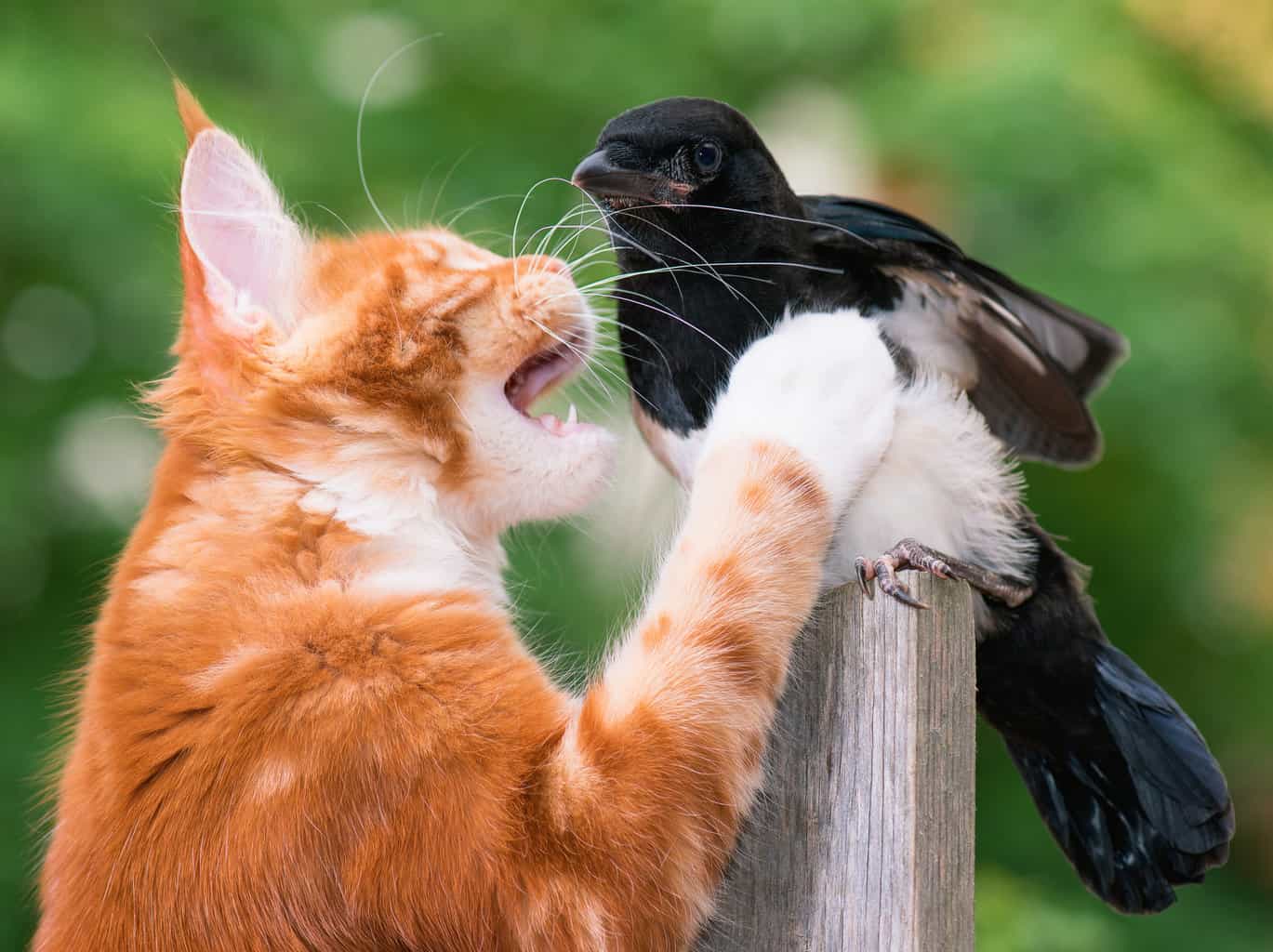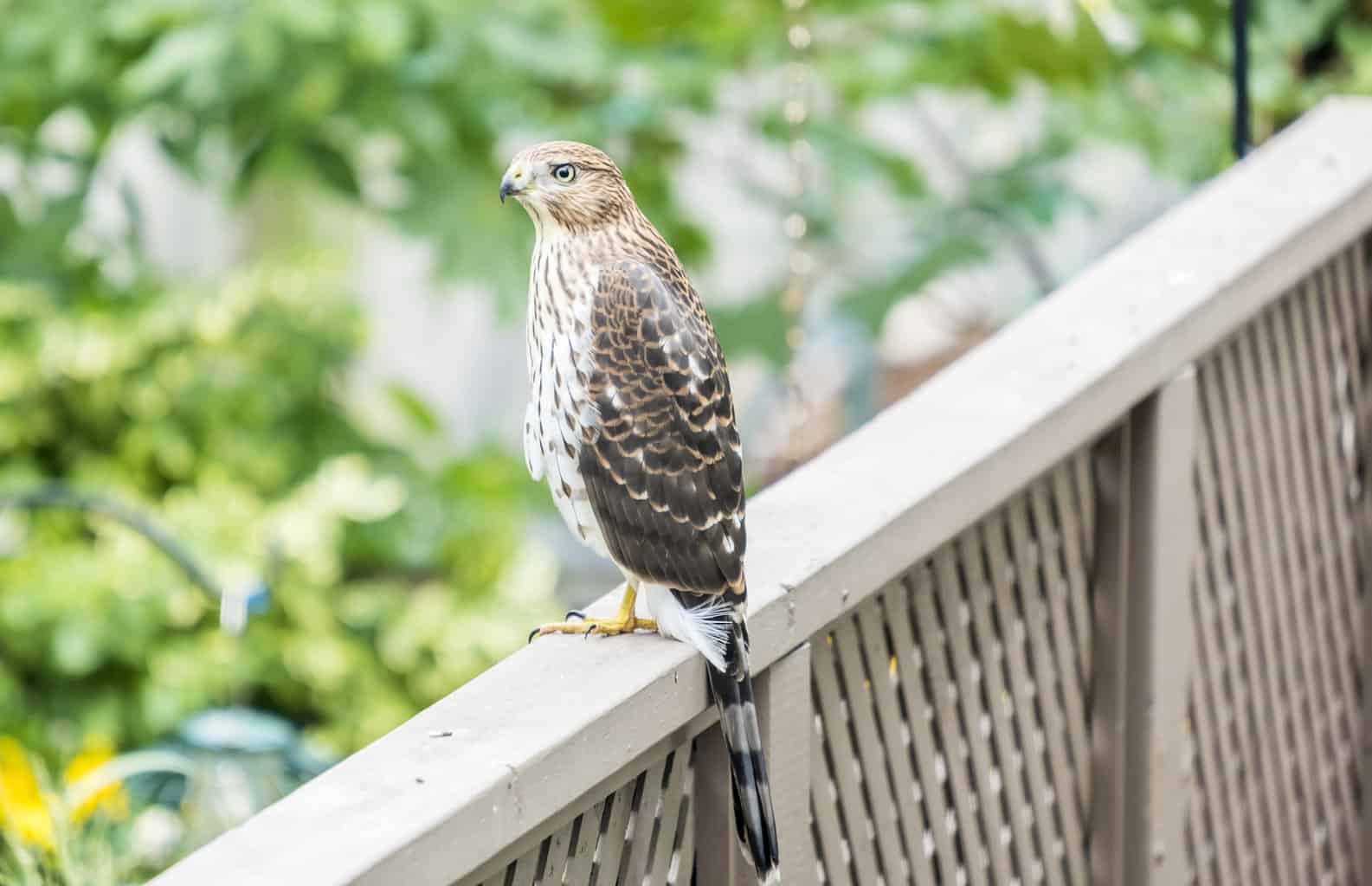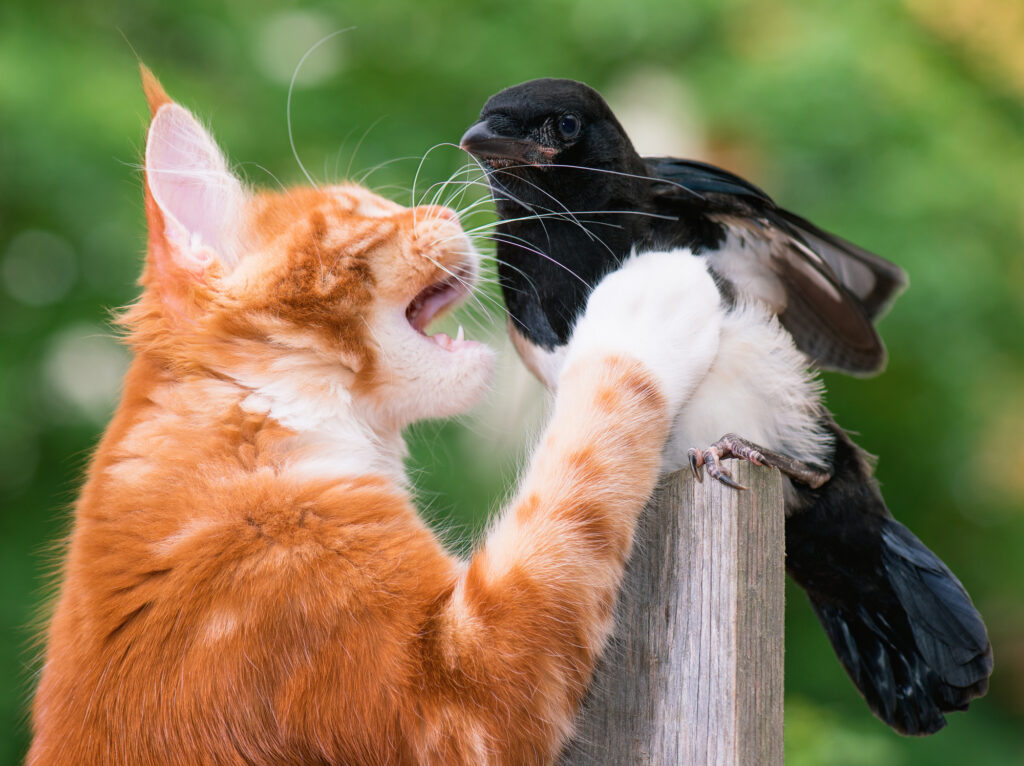When it comes to causes of death for wild birds, cats are in a category of their own. Cats are by far the top killer of wild birds, not including natural deaths, in the United States.
According to 2017 estimates from the United States Fish and Wildlife Service, cats are estimated to kill somewhere between 1.4 and 3.7 billion birds every year, with a median estimate of 2.4 billion.
That estimate is four times larger than the next-highest cause of death, collisions with building glass, which kill an estimated 600 million birds annually.
Collisions with vehicles (214.5 million) and poison (72 million) are the next two highest nonnatural killers of birds, according to the USFWS.
Cats are a serious problem, and not just to birds. They can wreak havoc on a backyard ecosystem if they aren’t controlled properly.
A study from researchers at the USFWS and Smithsonian Conservation Biology Institute estimated that cats kill 6.3 to 22.3 billion mammals annually.
Most of this damage is caused by unowned cats. While many cat owners let their cats roam free on occasion, cats that don’t belong to a particular person cause the most bird deaths.
Can Cats Actually Destroy an Ecosystem?
It’s impossible to know exactly how many birds are in the United States at any given time, and estimates vary widely. Wildlife Biologist John Trapp estimated that there are probably between 10 and 15 billion birds in the country in the spring and 20 to 30 billion in the fall.
Even without that frame of reference, 2.4 billion birds killed by cats is a serious concern. If that frame of reference is accurate, cats may be killing upwards of 10 percent of the country’s birds each year.
In small ecosystems, cats can do serious damage. According to USFWS and Smithsonian researchers, free-ranging cats on islands have caused or contributed to 14 percent of modern bird, mammal, and reptile extinctions.
Research also shows that cats can also locally reduce bird and mammal populations in mainland ecosystems.
What Can We Do As Cat Owners?
As a cat owner, you can keep your cat inside or supervised at all times. While your cat may enjoy meandering outdoors on occasion, these animals are hunters by nature.
Allowing your cat to roam free could be putting wild animals such as birds at risk, in addition to posing a risk that your cat could wander off or be hurt or killed by a wild predator.
If you do want to give your cat time outdoors, you may want to consider an outdoor cat enclosure.
These enclosures come in many different forms, from simple tents to towering, extravagant structures.
- Small & Delicate - Portable pet tent dimension is 48 x 48 x 23H inches, provide 16 square feet of activity space to cats, puppy,...
- Breathable & Half Sunshade - The design of half mesh and half polyester allows pets to better bathe in the sun, and can block...
- Unique Hammock Design – The playpen tent with a unique soft hammock, is perfect for pets that nap on the roomy beds, soak up the...
Last update on 2024-04-24 / Affiliate links / Images from Amazon Product Advertising API
- ★Cat catio cage on 4 wheels for easily move.2 of them are brake casters to fix well and keep safe.,Waterproof asphalt roof are...
- ★Upgraded version of the surrounding reinforcement wooden strip structure the product more robust and durable,3 tier wooden cat...
- ★Cat condo with removable bottom PVC layer for easy cleaning.2 big front doors and 2 small pulled up access doors with hook for...
Last update on 2024-04-24 / Affiliate links / Images from Amazon Product Advertising API
Not only will keeping your cat indoors keep your cat and wildlife safe, but it will also increase the comfort level of wild animals in your yard.
Birds and small mammals will likely stay away and find their food and homes in someone else’s yard if they can avoid a yard with a backyard cat.
What Can We Do As a Society?

Since most of the bird and mammal mortality caused by cats is not by human-owned cats, preventing these deaths isn’t as simple as cat owners keeping their pets inside, although that is advisable.
This is a very difficult question. What can we do?
One type of program implemented in some areas is a Trap, Neuter, Release/Return program (TNR), where cats are trapped, then spayed or neutered, and released back into the wild.
The idea is that these cats won’t reproduce and that the population will decrease significantly over time.
These programs have their critics. While groups like the Humane Society of the United States advocate for TNR programs, the American Bird Conservancy describes them as “a waste of time, money, and resources,” as they keep feral cats in the wild.
Since they don’t operate in a closed system, some research has found the programs to be ineffective in actually reducing feral cat populations.
Two studies (one conducted in Miami-Dade County, Florida, and another in San Diego County, California, and Alachua County, Florida )found that TNR was ineffective due to new cats moving into the areas and the difficulty of capturing and neutering the necessary number of cats to have an impact on reproductive rates.
However, others have found some success. According to one study in Chicago, where a county law was enacted to permit TNR in 2007, populations of cats declined by 82 percent from peak levels.
While TNR may not be the perfect solution, some believe it’s the best solution available right now.
Lethally removing tens of millions of cats across the United States is “economically and logistically impractical and publicly unacceptable in light of the mass euthanasia that would likely result,” as the Humane Society of the United States puts it.
Not only is it unacceptable in the public eye, but some people believe trap-and-kill programs are also ineffective.
Lethal control doesn’t permanently reduce the number of cats in an ecosystem, nonprofit group For All Animals claims.
Rather, it just removes a certain number of cats in what is called a vacuum effect. In time, the cats will reproduce until they reach their carrying capacity in that specific location.
The organization also says that trapping and lethal removal of cats are not done systematically in many locations. It’s just done whenever someone complains about a cat or two. Once those cats are removed, the rest of the cats remain, and the problem isn’t truly solved.
That brings us back to TNR programs.
According to the University of Florida, 75 percent of cats need to be sterilized in order to see a cat colony’s population start to reduce over time. When done correctly, it can result in the reduction of preventable cat deaths by 30 times, according to the University.
University of Florida Professor of Shelter Medicine Julie Levy says that the worst thing that can be done is nothing. TNR programs have a chance of getting the public and animal advocacy groups on board, as no cats will be killed in the process.
Both people concerned about bird deaths and advocating for cats have good intentions. Committing to well-run TNR programs in problem areas may be the best way to meet in the middle.
Other Threats to Birds
Unfortunately, cats are far from the only threat to birds. Billions of birds are killed each year by other human threats, in addition to natural deaths such as those from predators.
Collisions

Collisions with buildings, electrical lines, and vehicles are among the other serious issues that birds face throughout the world.
According to USFWS data, collisions with building glass kill an average estimated 599 million birds every year, collisions with vehicles kill an estimated 214.5 million, and collisions with electrical lines kill 25.5 million birds annually.
Collisions with building glass are the biggest threat to birds among possible collision sites. However, there are a couple of things you can do to help reduce bird collisions.
The easiest thing you can do is to make your windows bird-safe. First, find out which windows are causing, or could cause, significant confusion for birds.
Go outside and look at your windows. Those in which the reflection looks just like an outdoor landscape with no visible obstructions are likely to confuse birds and cause collisions.
Stopping collisions may be as simple as putting screens on your windows. The Cornell Lab of Ornithology emphasizes that it’s important to cover the entire window and have screens on the outside of your windows, however.
Otherwise, you can put decals, tape, stripping, or film on your windows to help keep birds away from them.
If you’re applying decals, it’s important to place them close together. Place them within a few inches of one another or else birds may just try and duck and dive around them.
Click here for a full breakdown of the ways you can reduce window collisions at your home.
You can also advocate for bird-safe windows in new public buildings in your town, encourage neighbors, friends, and businesses to make their windows bird safe, and push your town to adopt lights-out policies.
Street lights at night in big cities can cause bird fatalities by disorientating birds, causing them to waste energy and collide with buildings, especially on their migration paths.
By turning off unnecessary lights while birds are migrating, we can all help to reduce bird deaths.
Habitat Loss
Since 1970, North America’s bird populations have decreased by 2.9 billion birds, according to the American Bird Conservancy.
That’s over a quarter of the birds from the continent gone.
While cats, collisions with cars and buildings, and poisoning all contribute to this issue, habitat loss is the biggest problem that America’s birds face.
Habitat degradation, where the habitat isn’t destroyed entirely but loses some of its ability to support birds, is the second-leading cause of bird decline, according to the American Bird Conservancy.
Certain birds require expansive or specialized habitats. A new suburban subdivision that replaces an open field might work out perfectly fine for a pair of cardinals, but it isn’t going to work for a bobolink.
Bobolinks, whose numbers have declined in a serious way, require prairie and grassland habitats. To preserve bobolink populations, we need to prioritize the habitat in which they thrive.
This is just one example, but grassland birds are among those most in need of our help. Since 1970, there has been a 53 percent reduction in grassland bird populations, according to the American Bird Conservancy.
Habitat loss is the chief cause of this problem. Of the 550 million acres of grasslands that stretched from Alberta to Mexico at one point in history, less than 40 percent remains, according to the National Audubon Society.
Coastal shorebirds have also lost more than a third of their population and forest bird populations have dropped by more than a billion birds.
Aerial insectivores like swallows and flycatchers have lost nearly a third of their population, according to the American Bird Conservancy.
Across the board, North America is losing birds, so what can you do?
Plant native plants, advocate for expansive wild spaces that support specialized birds, and avoid pesticides. While some bugs may be annoying, birds like swallows and flycatchers rely on them to live.
Other suggestions from the American Bird Conservancy include drinking shade-grown coffee, reducing plastic use, and doing citizen science such as bird counts and surveys.
Predators

Sometimes, death is a necessary part of nature’s cycle. Birds of prey and other wild animals need to eat, after all.
Some people may choose to provide protective measures for songbirds to increase the number of birds in their backyards, while others may choose to let nature take its course.
If you want to take steps to protect your backyard songbirds from predators, click here.
FAQs
What is the leading cause of bird deaths in North America?
Cats are the leading human-influenced cause of bird deaths in North America, according to data from the U.S. Fish and Wildlife Service, which estimates that between 1.4 billion and 3.7 billion birds are killed by cats annually.
What can we do to help reduce bird deaths?
You can help reduce bird deaths in several ways, including keeping cats inside, making your windows bird-safe, planting native plants, reducing or eliminating pesticide use, and advocating for bird-safe structures to be built and bird habitats to continue to be protected.
You can also help monitor bird populations by participating in citizen science surveys and bird counts.
Why do cats kill birds?
Cats are natural hunters. Even if they don’t need food and they’re used to life as a housecat, it’s in their nature to hunt.
This is why even the best-behaved cats should not be left outside unsupervised.

